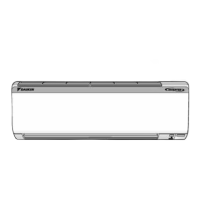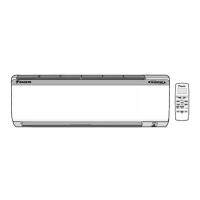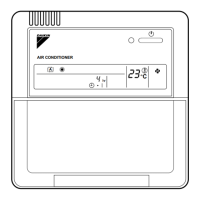Do you have a question about the Daikin MPS015 F and is the answer not in the manual?
Details about the unit nameplate's information, including model, serial, electrical characteristics, and refrigerant.
Explains the meaning of DANGER, WARNING, and CAUTION symbols for safety.
Explains the model number breakdown for the Daikin Packaged System series.
Outlines the installer's duties regarding compliance with codes and regulations.
Procedures for checking equipment upon delivery for completeness and damage.
Recommended clearances for unit access and servicing of components.
Minimum clearance recommendations for unit ventilation and airflow.
Restrictions for overhead obstructions above the unit's air handler section.
Guidance on locating and installing the roof curb for proper unit support.
Step-by-step instructions for assembling the roof curb components.
Safety precautions and procedures for lifting and handling the unit.
Instructions for correctly connecting the unit's condensate drain pipe.
Information on factory-installed damper actuators and linkage adjustments.
Guidelines for connecting ductwork to the unit, including flexible connections.
Field installation of static pressure taps for VAV units.
Field installation of static pressure taps for building pressurization control.
Guidelines for field power wiring connections and compliance with codes.
Lists available field control connections for rooftop units.
Procedures for releasing and adjusting spring mounts for supply fans.
Details about the gas heat module, its certification, and installation clearances.
Information on factory-installed gas furnaces and their components.
Requirements for ventilation and flue piping for the gas furnace.
Requirements for installing the gas furnace module by qualified personnel.
Instructions for installing the OA hood before furnace operation.
Details on electrical power supply to the burner and factory wiring.
Requirements for gas piping sizing, installation, and leak testing.
Procedures for isolating the appliance from the gas supply system.
Information on furnace identification for different elevations.
Steps to adjust manifold pressure for natural gas furnaces.
Steps to adjust manifold pressure for propane gas furnaces.
Details the operation sequence for staged gas heat.
Details the operation sequence for modulating gas burners.
General recommendations for start-up and service by trained technicians.
Defines responsibilities for ensuring proper furnace operation.
Steps to follow before initiating unit start-up.
Step-by-step procedure for starting the unit and thermostat settings.
Procedure for safely turning off gas supply to the unit.
Guidelines for planned maintenance and typical service intervals.
Diagram of the ignition control module for staged gas furnaces.
Troubleshooting guide using LED indicators on the ignition control module.
Diagram of the ignition control module for modulating gas furnaces.
Describes the electronic controller for modulating furnace operation.
Troubleshooting guide for modulating gas furnace LEDs.
Overview of electric heat design, safeties, and capacity data.
Explanation of the hot gas reheat coil option for dehumidification.
How dehumidification is initiated based on humidity sensor values.
Details on MHGRH operation, PI loop, and compressor staging.
Describes alternate staging for MHGRH and compressor operation.
Information on hot water coil options and piping vestibule.
How the enthalpy wheel provides energy recovery and control.
Information on the construction and maintenance of the enthalpy wheel.
Critical factors for minimizing crossover and allowing purge operation.
Factory-installed frost protection options for the system.
How constant speed motors prevent frost on the enthalpy wheel.
How variable speed motors prevent frost on the enthalpy wheel.
Explains the technology used for airflow measurement.
Wiring instructions for connecting the outdoor air monitor.
Configuration steps for the outdoor air monitor controller.
Changing units, converting signals, altitude, and output filter settings.
A table of common problems and their remedies for the transmitter.
A table of troubleshooting steps for the transmitter.
Optional control for economizer based on enthalpy.
Using an external time clock for scheduling unit operation.
Information on exhaust fan options for economizer units.
Functionality of airflow and filter monitoring switches.
Information on field-powered and unit-powered GFCI receptacles.
How condenser fan speed modulates for VFD compressors in low ambient.
Overview of VFD compressor operation with fixed speed compressors.
Control of VFD compressor via digital enable and analog signal.
How dehumidification affects VFD compressor operation in cooling mode.
Sequence for managing oil level in VFD compressor sumps.
Control functions to protect VFD compressor from abnormal conditions.
How discharge line temperature affects VFD compressor speed.
Monitoring and adjusting superheat for VFD compressor operation.
Control of the solenoid valve for condenser coil splitting.
Emergency stop function for VFD compressors.
Overview of variable speed scroll compressor features and operation.
Control of the oil injection valve for compressor lubrication.
Monitoring oil level in VFD compressor sump using an optical sensor.
Details on the VFD used for VFD compressors and its operation.
Wiring diagram for VAV power with fixed speed scroll compressors.
Wiring diagram for VAV power with VFD compressor.
Wiring diagram for VAV power with VFD compressor.
Wiring diagram for CAV power supply.
Wiring diagram for VAV control with VFD compressor.
Wiring diagram for MPS 026 VAV control without low ambient.
Wiring diagram for VAV control with VFD compressor.
Wiring diagram for VAV control with VFD compressor and low ambient.
Wiring diagram for VAV control outputs for staged gas heat.
Wiring diagram for CAV control inputs.
Wiring diagram for CAV control outputs (staged gas heat).
Wiring diagram for VAV/CAV control outputs (modulating gas heat).
Wiring diagram for electric heat option power supply.
Wiring diagram for electric heat option outputs.
Wiring diagram related to energy recovery components.
Wiring diagram for the main control board with energy recovery.
Graphic representation of unit operating state transitions.
Initial 3-minute start-up state with fan off.
3-minute state mixing air in ductwork and space.
State where OA damper modulates to minimum position.
Unit operation in cooling mode based on control temperature.
Cooling operation for CAV units using space temperature.
Cooling operation for VAV units using discharge air temperature.
How the economizer functions as the first stage of cooling.
Safety precautions for servicing control panel components.
Procedures to ensure proper unit operation after installation.
Steps for applying power to the unit and control panel.
Procedures for starting the supply fan and verifying rotation.
Checking and initiating economizer operation.
Procedures for starting the compressor, including safety checks.
Verifying correct rotation direction for scroll compressors.
Recommendations for checking refrigerant subcooling.
Adjusting the expansion valve superheat setting.
Verifying alignment of motor and fan sheaves.
Adjusting belt tension for optimal operation and belt life.
Performing air balancing by a qualified technician.
Pre-startup checks for the energy recovery wheel.
Adjusting diameter seals for proper wheel clearance.
Setting heating, cooling, and other parameters for normal unit operation.
Recommends recording and saving controller setpoints for future reference.
General guidance for service maintenance by qualified personnel.
Routine maintenance items and recommended inspection frequencies.
Safety precautions for servicing control panel components.
Design features of all-aluminum condenser coils and corrosion prevention.
Instructions for connecting aluminum coils to copper tubing using low-temp brazing.
Recommended cleaning procedures for Option E coated coils for warranty.
Approved cleaning agents for Option E coated coils.
Warnings against using harsh chemicals or high-velocity water on coils.
Overview of individual motor control and protection devices.
Function and adjustment of the manual motor protector.
Description and adjustment of thermal overload relays.
Information on circuit breakers for short circuit protection and resetting.
Advantages of spring clamp terminals and connection methods.
Function of PVM in protecting loads from power line issues.
Procedures for using the through-the-door disconnect switch.
Precautions and procedures for storing the unit on-site.
Guidelines for lubricating motor and fan bearings.
Six-month checks for wear and tightness of components.
Maintenance overview for the energy recovery wheel.
Information on drive belt inspection and replacement.
Procedures for cleaning the energy recovery wheel.
Adjusting diameter seals for proper wheel clearance.
Steps for installing and replacing wheel segments.
Procedures for replacing the wheel drive motor and pulley.
Detailed steps for replacing the drive belt.
Common symptoms and causes related to the energy recovery wheel.
Importance of checking setscrews for fan wheel and sheave security.
Ensuring proper alignment for fan wheel and funnel.
Details on servicing refrigerant sensors and switches.
How to obtain replacement parts from Daikin.
Information on compressor warranty and replacement.
Procedure for returning materials under warranty.
Fields for job name, installation address, and contact details.
Fields for unit model, serial number, and compressor details.
Checklist for initial inspection of the unit before operation.
Recording supply and return fan performance data.
Checks for compressor holding charges, rotation, and start-up sequence.
Recording compressor voltage, amperage, and pressure readings.
Procedures for checking and starting electric heat operation.
Specifications and checks for gas burner operation.
Recording gas pressure performance for modulating heat.
Performing a pressure test on the hot water coil.
Checks for heat wheel rotation, VFD operation, and air bypass.
Verifying power supply and calibration of the measuring station vane.
Importance of recording and updating control parameters.
Survey questions on shipping damage, appearance, fit, leaks, and controls.
Overview of the MicroTech III menu structure.
Menu options for manual control of unit functions.
Accessing service menus for timers, alarms, and configuration.
Options for enabling trending and selecting data points.
Menu for checking operating hours and BMS communication.
Accessing unit status, settings, temperatures, and flow information.
Menus for commissioning unit settings like fans, economizer, and heating.
Status of network inputs like OAT and Space temperature.
Status of Modbus communication for various components.
Status and settings related to D3 controller.
Calibration offsets for temperature and humidity sensors.
Settings for alarm limits and output configuration.
Status of analog inputs from sensors.
Status of universal input/output channels.
Status of digital inputs.
Status of digital outputs.
Settings for LON, BACnet, and D-Net communication.
Options for configuring data trending and points.
How to change measurement units for the outdoor air monitor.
Configuration menu for the outdoor air monitor settings.
| Brand | Daikin |
|---|---|
| Model | MPS015 F |
| Category | Air Conditioner |
| Language | English |












